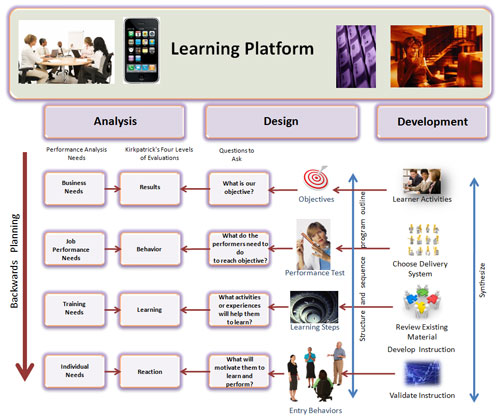Note: This site is moving to KnowledgeJump.com. Please reset your bookmark.
Delivering the Learning Platform in Instructional Design
The Implementation phase is where the learning, training, processes, Products, and services are actually delivered to the learners. This total package is called a Learning Platform.
A learning platform is an integrated set of services that provide the learners with information (content); tools, such as social learning media; activities; and resources, that support and enhance their quest to learn new skills and knowledge and supports the learners' Personal Learning Environment (PLE).
To some, this may sound like the easy part, but it can be the hardest part of the system. Good trainers can make a poorly designed program work well and a well designed program work great... bad trainers can make neither work. If the learning platform is delivered in a different manner, such as elearning or a Job Performance Aid, the platform must still be supported.
Jim Heskett, a Harvard Business School professor wrote (2009):
“Learning is more strongly influenced by individual teachers, for example, than any other factor, including class size and quality of the facilities. In various studies, the truly great teachers do things like giving good, individualized feedback while remaining sensitive and responding to interactions going on around them that might indicate needs of other students.”
Through their experience, training, and education, skilled instructors are able to transform an inanimate platform into a living experience for the learners.

The learning platform may consist of only a small single piece of courseware, such as a 20 minute elearning course, a mobile performance support app, or a blending learning environment that consists of of several pieces of courseware, such as classroom, elearning, and performance support that takes several hours or days to complete.
If the learning platform has no instructors assigned to it, such as a stand-alone elearning program, then other means should be provided to assist the learners when they need it, such as a support line, discussion group, Twitter contact (micro blog), etc.
Underlying Support
The Analysis, Design, and Development phases provided the underlying support to ensure the learning platform:
- Performs as predicted (solves a real business need)
- Flows with the job performance needs (improves job performance rather than interrupt it)
- Supports the training and learning needs
- Ensure the learners see the training as important and doable so that they are motivated to engage with it (Markus, Ruvolo, 1990)

Click for larger image
Beyond Implementation
You might think of the Implementation or Delivery phase as just “starting the training;” however it actually starts with creating the Learning Management Plan (LMP) that outlines the steps and required resources to successfully implement the learning platform. It informs the learning/training team how to deliver the training according to plan and with maximum learner involvement. Non-trainer led learning platforms, such as a stand-alone elearning program, should also include a LMP.
Next Steps
Go to the next section: Learning Management Plan
Return to the Table of Contents
Reference
Heskett, J. (2009). Why Can't We Figure Out How to Select Leaders? Retrieved from: http://hbswk.hbs.edu/item/6103.html
Markus, H., Ruvolo, A. (1990). Possible Selves: Personalized representations of goals. Goal Concepts in Psychology. Pervin, L. (ed), pp211-241. Hillsdale, NJ: Lawrence Erlbaum.
